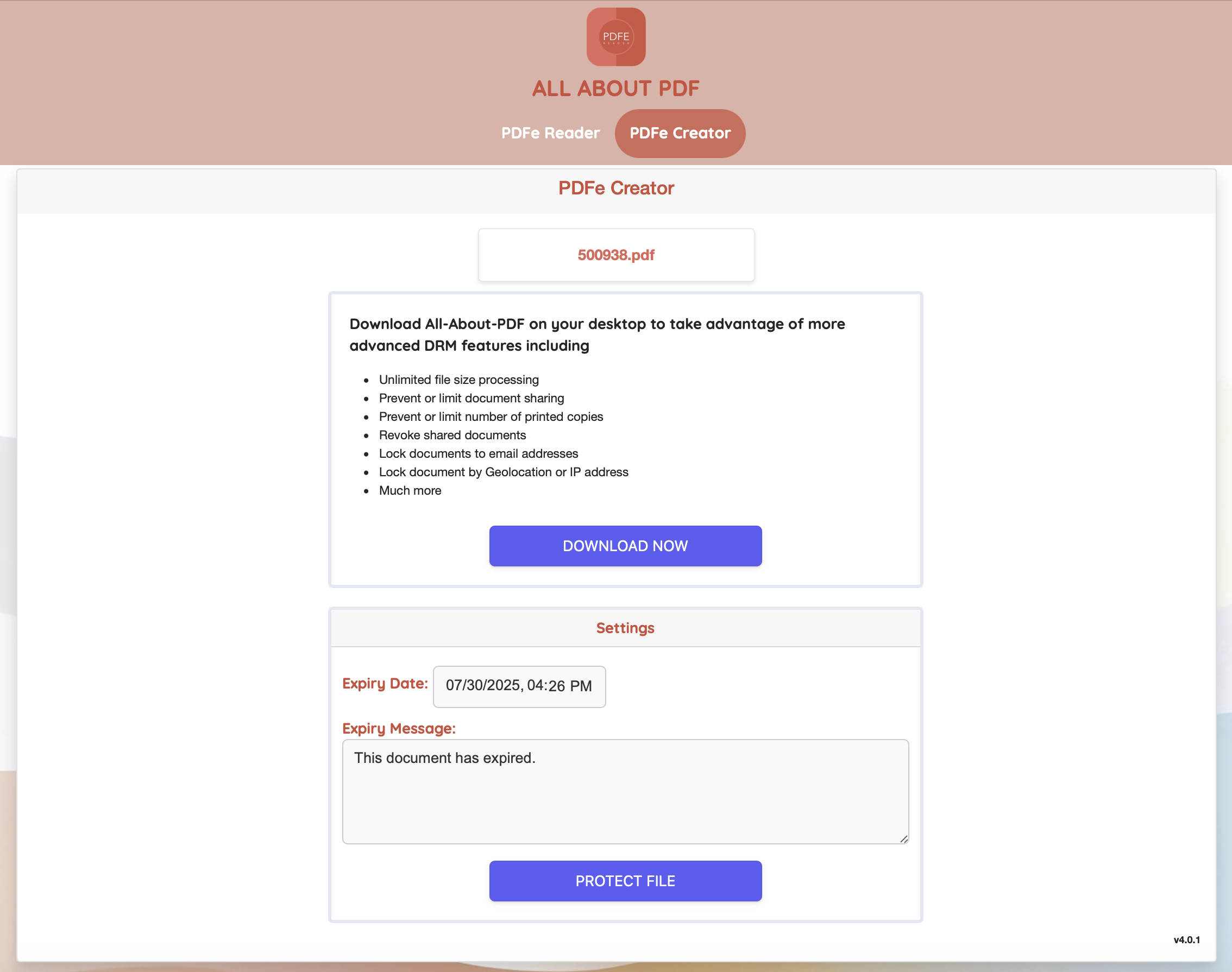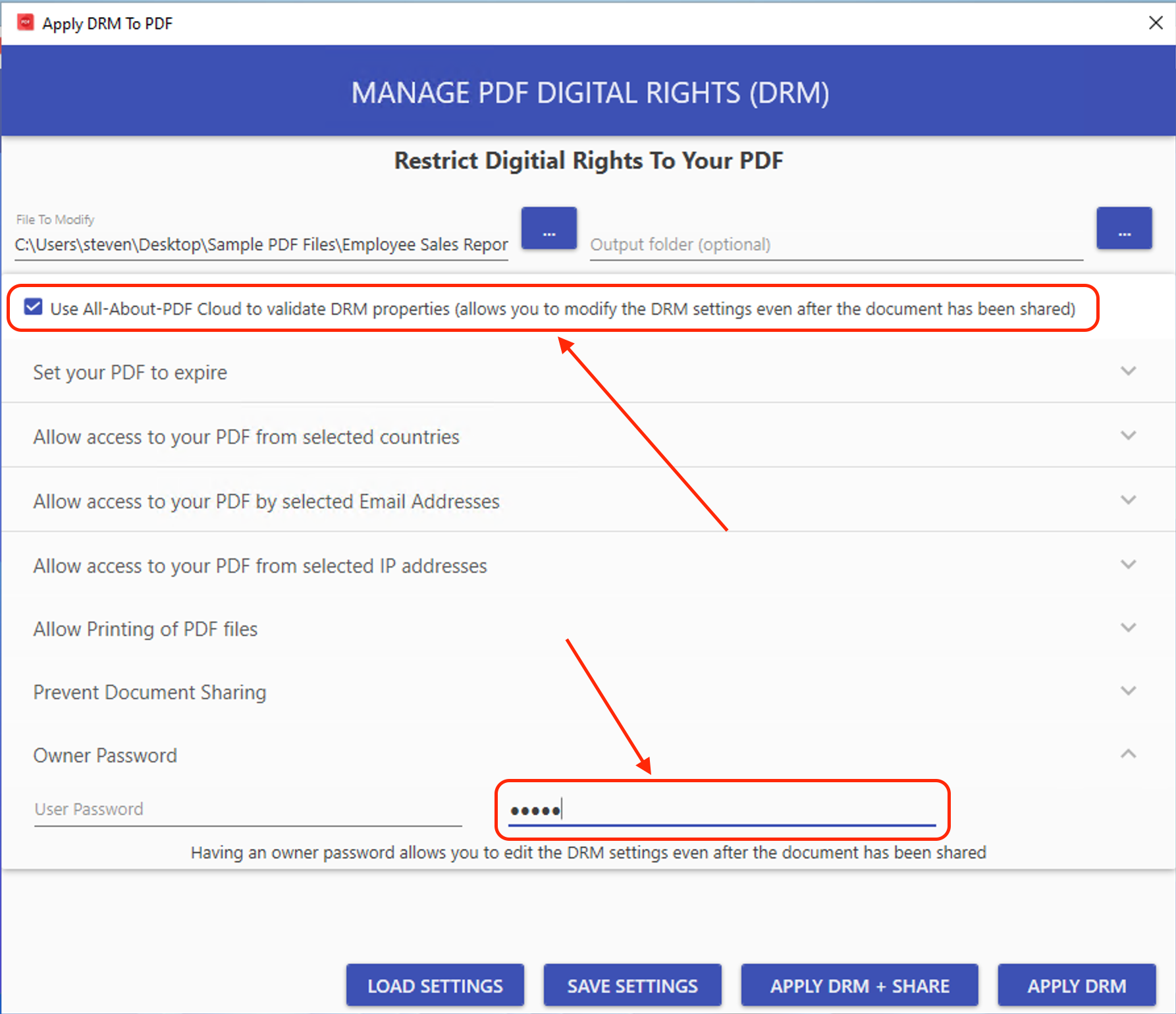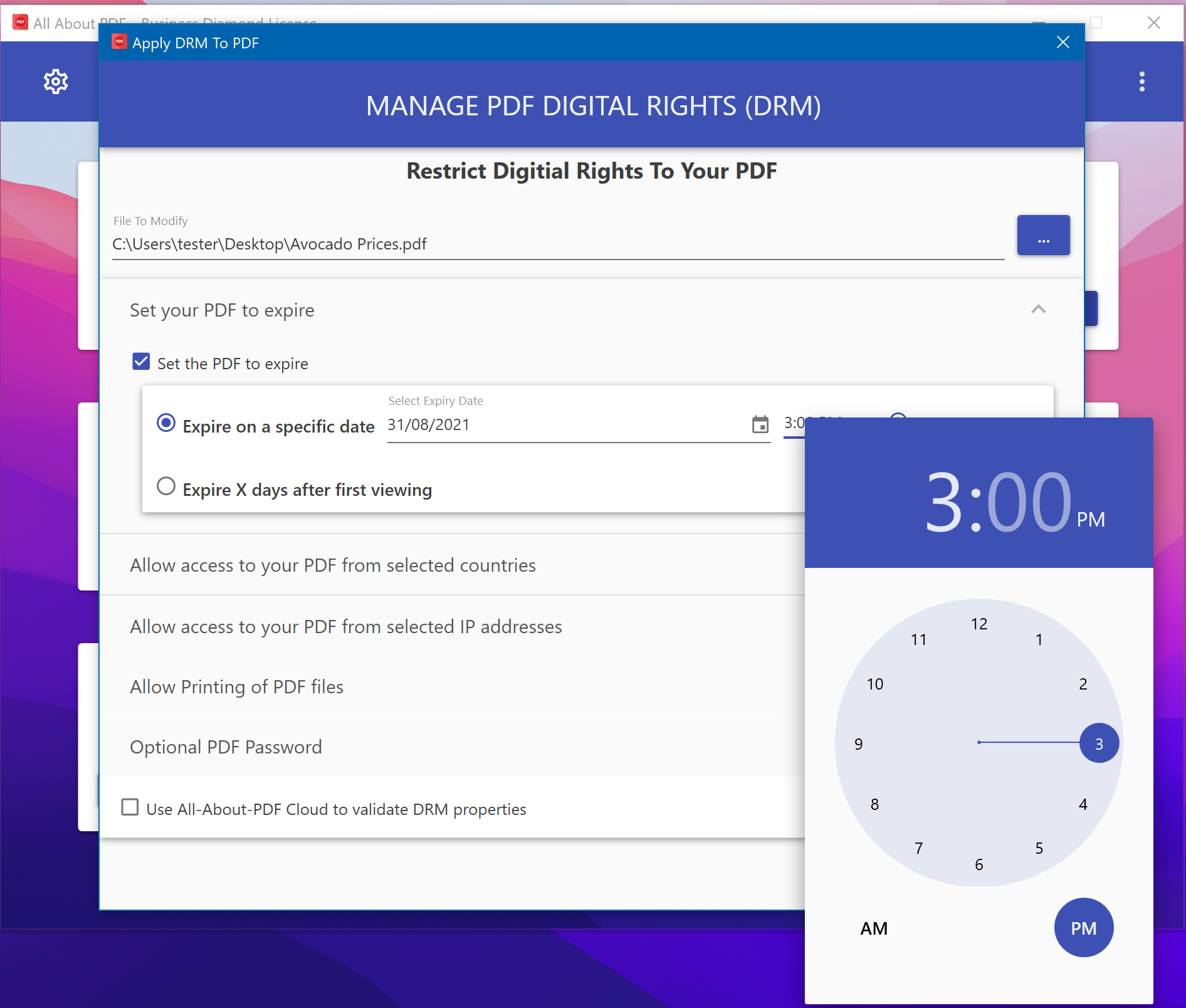Not all PDF tools are created equal. While most handle simple tasks like converting or merging files, All-About-PDF is built for real power users—offering automation, DRM protection, batch processing, Watch Folders, advanced splitting, content search, and more. When your PDF needs go beyond the basics, All-About-PDF is the tool that stands out.
Just Launched: DRM Protection of PDF Files in Your Browser - For Free
We’re excited to announce a powerful new feature at PDFEReader.com: you can now create PDFe files directly from your browser — no downloads, no subscriptions, no fuss.
What’s a PDFe file? It’s our proprietary, DRM-protected format that gives you greater control over how your documents are accessed and used. Whether you’re sharing reports, course materials, or private documents, this feature helps you protect your content and set an expiry date so the file automatically becomes inaccessible after a certain period.
🔐 What You Can Now Do WITH PDFe FILES
Protect your PDFs with DRM instantly
Set expiry dates so files stop working after a chosen date
Prevent unauthorized sharing and copying
Prevent unauthorized printing of your documents
Set geographic access controls to your intellectual property
Why This Matters
Traditional PDFs offer limited control once shared. Anyone with the file can copy it, forward it, or store it forever. But with PDFe files, you stay in control. This is especially useful for:
Educators sharing time-limited course content
Businesses distributing sensitive documents
Freelancers or creators delivering paid work
Anyone who wants to secure their intellectual property
Get Started in Seconds
Go to https://pdfereader.com
Select the PDFe Creator tab
Upload your PDF
Set an expiry date
Provide the expiry message
Download your new PDFe file — ready to go!
Try It Out — And Let Us Know What You Think
We built this with privacy, simplicity, and accessibility in mind. No logins, no tracking — just powerful tools to help you take control of your PDFs.
Give it a go, and drop us a message with your feedback. We’re just getting started.
Don't Let AI Peek at Everything: How All-About-PDF Keeps Sensitive Files Off-Limits
In a world where AI tools can instantly summarize websites, scan documents, and extract insights from large volumes of text, it’s easy to lean into the convenience. AI is proving useful in all kinds of areas—from customer support and legal research to content creation, academic analysis, project management, and financial planning. With just a few prompts, it can sift through dense reports, highlight key takeaways, and boost productivity across the board.
But as powerful as AI has become, not every file should be accessible to it—and if you're serious about PDF security, that distinction matters more than ever.
AI is Smart—But It’s Not Always Safe
AI-powered tools like chatbots, summarizers, and online PDF viewers are incredibly helpful. But what many people don’t realize is that once you upload a document to a cloud-based platform, you may be handing over more access than you intended. Some platforms quietly scan, index, or retain your files for future training or analysis. If you’re working with:
Confidential business reports
Proprietary data
Legal documents
Financial statements
Client deliverables
Internal strategy decks
...then your PDFs shouldn’t be left exposed.
How All-About-PDF Solves This Problem
This is where All-About-PDF’s PDF DRM platform comes in.
Unlike basic password protection or simple encryption, All-About-PDF provides true Digital Rights Management for PDF files, letting you:
Restrict who can view, print, copy, or share your documents
Set expiry dates or revoke access at any time
Shield your PDFs from unauthorized AI analysis, indexing, or scraping
Protect files even after they’ve been downloaded
Your data stays local. Your rules stay enforced. And your documents stay out of reach from automated systems that weren’t invited in.
Use AI Where It Makes Sense—Protect What Matters
AI is a powerful tool, but some documents are too sensitive to leave vulnerable. Whether you’re managing internal operations, delivering paid content, or protecting client data, you deserve a PDF solution that puts you in full control.
👉 Try All-About-PDF today and lock down your most important files with confidence: https://allaboutpdf.com
Happy 30th Birthday, PDF!
June 15, 1993, marked a significant milestone in the world of digital documents—the birth of the Portable Document Format, better known as PDF. Developed by Adobe Systems, the PDF format has revolutionized the way we create, share, and consume electronic documents over the past three decades. As we celebrate its 30th birthday, let's take a journey through time and explore how PDF has transformed the landscape of document management and communication.
The Birth of PDF
Adobe co-founder Dr. John Warnock and his team created the PDF format out of the need for a universal document exchange format to preserve the original content's integrity across different platforms, operating systems, and software applications. With its release, PDF offered a solution to the compatibility issues faced by users when sharing documents electronically.
Cross-Platform Compatibility
One of the critical strengths of PDF is its ability to maintain consistent formatting across different devices and platforms. Whether you're opening a PDF on a Windows PC, Mac, Linux machine, or mobile device, the document will retain its original layout, fonts, and graphics. This universality has made PDF the go-to format for sharing and distributing documents.
Document Preservation
Unlike other file formats that can be easily altered or corrupted, PDFs preserve the integrity of the original document. By encapsulating text, images, fonts, and formatting into a single file, PDF ensures that the content remains intact and looks the same regardless of the software or hardware used to open it. This has been particularly valuable for industries such as legal, finance, and government, where document integrity is critical.
Enhanced Security Features
PDF introduced robust security features, such as password protection, digital signatures, and encryption, enabling users to protect sensitive information and control access to their documents. These security measures have played a vital role in safeguarding confidential data and ensuring the authenticity and integrity of digital records.
Interactive Elements and Multimedia Integration
As technology evolved, so did PDF. In addition to static documents, PDFs now support interactive elements, such as hyperlinks, bookmarks, and form fields, transforming them into dynamic and engaging experiences. Furthermore, PDFs can seamlessly integrate multimedia elements, such as audio, video, and interactive 3D models, enhancing the presentation and comprehension of complex information.
Accessibility and Inclusivity
PDF has made significant strides in improving accessibility for individuals with visual impairments or other disabilities. Through the implementation of features like tags, alternative text, and reflow options, PDFs can be made screen-reader friendly, ensuring equal access to information for all users. This inclusivity has been instrumental in promoting digital equity.
Paperless Workflows and Sustainability
The adoption of PDF has facilitated the shift towards paperless workflows, reducing the reliance on printed documents. This not only saves costs and time but also contributes to environmental sustainability by minimizing paper consumption and waste. With digital signatures and workflow automation, businesses have been able to streamline processes and improve efficiency.
As we celebrate the 30th birthday, we must look to the future and ask what's next for the venerable format. To us, the next step is to improve PDF document security. This should be done by standardizing DRM security for PDF files to democratize access to robust document security, thereby enabling individuals and organizations to regain control over their intellectual property and confidential information. Until such time where DRM protection for PDFs is standardized, users have to rely on solutions such as All-About-PDF’s PDFe format.
From its inception, PDF has overcome compatibility challenges, transformed document preservation, and enabled secure and interactive experiences. Its accessibility features, support for multimedia, and contribution to sustainability have further solidified its importance in our digital lives.
Happy birthday, PDF!
How To Share PDFe Files Via Email in All-About-PDF
When you protect a document with our best-in-class Digital Rights Management (DRM) technology for PDF documents, a task that usually follows is to share it with others via email. We decided to streamline this process by enabling you to protect PDF files and email them in a straightforward process from within All-About-PDF. Here is how to do it:
Get started with All-About-PDF today by downloading our free unlimited 14 day trial.
How To Restrict PDF Documents By Email Address(es)
If you would like to prevent unauthorized users from reading your sensitive documents, one way of achieving that is by specifying the email addresses of the people allowed to access your PDF documents.
To restrict access to a PDF to specific email addresses, follow the steps below:
Open All-About-PDF from the Windows Start menu
Click on the “Apply DRM” button from the Home screen.
The DRM Protection screen will open.
Select the PDF file or folder containing the files you would like to protect. You can also use wild cards to process multiple PDF files.
Expand the “Allow Access By selected Email Addresses” section and check the box to "Lock PDF to the following Email Addresses."
Use the + button to add a list of allowed email addresses.
Configure any other DRM options, such as expiry date or device locking. When Email Address Locking is used together with Device Locking, it is configured as devices per email addresses i.e. each specified email address can open the document on the configured numbers of allowed devices.
Click the “Apply DRM” button to protect the document
You can now share the resulting PDFe files without worrying about prying eyes.
Introducing All-About-PDF Cloud Sync
This week saw the release of All-About-PDF Build 2004, and one of the significant features of this release is the long-awaited All-About-PDF Cloud Sync.
What is All-About-PDF Cloud Sync?
Put simply, All-About-PDF Cloud Sync is our platform that allows you to modify the DRM settings of your PDFe documents even after the file has been shared/distributed.
Let's look at an example; say you have a PDFe file with a specific expiry date and, has a list of emails that are permitted to view the file's contents. The file is then distributed to your clients.
With All-About-PDF Cloud Sync, you can modify the document's DRM settings such as, expiry date or list of allowed emails by simply editing the original PDFe file. All-About-PDF will synchronize all your local changes to our cloud and automatically apply them to all the distributed copies of the document.
An owner password and cloud sync allow you to edit PDFe files even after they have been shared
To get started with All-About-PDF Cloud Sync, follow the steps below:
If you haven't already, download and install the latest version of All-About-PDF from here
Open All-About-PDF and then click on the Apply DRM button.
As usual, select the PDF that you would like to protect.
You can specify the Output folder if you want to save the PDFe file to a different location from the original file.
Check the box to "Use All-About-PDF Cloud to validate DRM properties."
The app will prompt you to provide an Owner password if your goal is to edit the PDFe file later.
Provide a secure Owner password.
You may now edit the rest of the DRM settings such as Expiry Date, Allowed Emails, Sharing Controls, etc.
Click on the Apply DRM button to generate the secure PDFe file.
With the PDFe file generated, you can now distribute it to your clients and users with the peace of mind that not only is your intellectual property protected, you can also modify access to the file at any given moment.
Let's see how this works.
To edit the PDFe file, filter Windows file picker to show PDFe files
First, open All-About-PDF and click on Apply DRM button.
Click the File Browser button to select your existing PDFe file. Be sure to change the filter from PDF to PDFe, as shown below.
All-About-PDF will prompt you for your Owner password; no one can edit your PDFe file without it.
You can now edit the DRM settings as usual and click the Apply DRM button to save the changes. The DRM settings on your local computer are immediately uploaded to the All-About-PDF Cloud and synchronized with all the distributed versions of the document.
All-About-PDF Cloud Sync feature is compelling as it allows you to remotely extend or shorten a document's expiry date, modify the list of permitted email addresses to access the document, or even revoke all access to the document.
Download All-About-PDF today to see how All-About-PDF Cloud Sync can benefit you and your organization.
Convenience vs Security
When it comes to life in general, convenience and security are almost always on the opposite ends of the same spectrum.
For example, if you wanted your home to be highly secure, you could add a third or fourth lock to all the doors; this would undoubtedly increase security, but it would be very inconvenient to enter the house.
The same quandary presents itself when we are dealing with technology systems. A short and easy password, such as "1234", is convenient; however, it is also very easy to guess. We are therefore advised to use long and complex passwords as well as multi-factor authentication. We trade convenience for security because, in this case, it is worth it.
When it comes to securing intellectual property in our PDF documents, two options come to mind.
More convenience, less security.
The first option is to protect the document using PDF permissions and an Owner password. With these permissions, you can limit the PDF file from being printed, edited, having contents copied, and a few other options. You can also add PDF expiry by adding PDF JavaScript into the mix.
As you would expect, it is very convenient to view PDF files that have been protected with this method because any PDF viewer can open them. The downside to PDF permissions is that it is wholly dependent on the PDF reader whether it will obey the permissions or not. If a user were to use a non-compliant reader, it would automatically bypass all the security you have placed on the document. Users can also take screencaps of the PDF reader to capture the document’s contents.
Adobe Acrobat's warning regarding permissions and third-party products
More security, less convenience.
The second option for securing PDF documents is to use Digital Right Management (DRM) technology such as All-About-PDF's PDFe files. In this scenario, the document is wrapped in an encrypted security layer that can hold a virtually unlimited number of permissions and can introduce features such as expiry dates, printing limitations, sharing limitations, screen capture blocking, and so much more. To guarantee the security of the intellectual property, DRM-protected PDF files can however only be viewed using proprietary readers.
As a user, it is then up to you to examine what you are trying to protect, its value and determine which side of the spectrum you will be on. Are you going to lean towards providing more convenience to your users while sacrificing the security of your intellectual property? Or are you going to introduce some inconvenience to consuming your content while ensuring that it is secure and protected?
Best of Both Worlds?
Fortunately, we at All-About-PDF like a good challenge and have been wrestling with this very issue. We have come up with a few options to reduce the inconvenience caused by using proprietary DRM technology without sacrificing any of the security benefits. These include:
Our PDFe Reader (used to read DRM protected PDF files) is free for everyone to download
Our PDFe Reader is available on all major platforms, including Windows, macOS, iOS, iPad, Android, and the Web.
With the ability to "DRM and Share" in our apps, you can protect your PDF file with our leading-edge DRM technology and share the resulting URL that the user can open in any web browser on any device.
With All-About-PDF’s DRM protection, we are continuously striving to strike a balance between excellent security for your intellectual property and convenience for your end users. Get started today by downloading our free 14-day trial.
Limit How Many Times a PDF File Can Be Printed
When you protect a PDF document with our DRM technology, printing is also disabled by default. There are, however, some instances when you would like to allow the document end-user to print some copies of the file.
Follow the steps below to achieve this using All-About-PDF's (digital rights management) DRM technology.
If you haven't already, make sure you are using the latest version of All-About-PDF from our website as well as the latest PDFe Reader (at least build 1072).
Open All-About-PDF from the Windows Start menu and then hit the "Apply DRM" button.
On the screen that opens, select the PDF document that you would like to protect with DRM and then, If desired, set the document's expiry date by expanding the "Set your PDF to expire" section.
Under the "Allow Printing of PDF files" section, you can check the "Allow printing of protected file" checkbox and then specify how many times your end-user is allowed to print the file.
Hit the "Apply DRM" button to protect your file; the resulting DRM protected file is saved in the same location as the PDF file with a ".pdfe" extension.
All-About-PDF’s DRM technology automatically prevents the documents from being printed to PDF and document printers as well as prevents screen capture of the document.
Free PDFe Reader Now Available for iPhone and iPad
We are happy to announce the general availability of our free PDFe Reader for iPhone and iPad. You and your users can now open and read the DRM protected PDF files on the go and on your tablets!
p/s You can add expiry dates to your PDF documents using All-About-PDF for Windows. See this link for more information.
Download from the Apple App Store using the link below
Or simply scan this QR code.











